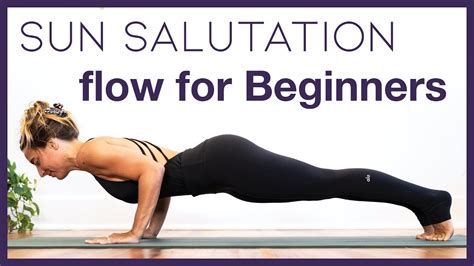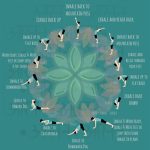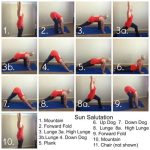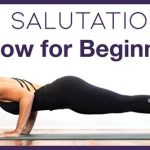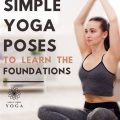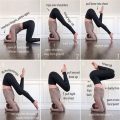Mastering Yoga Sun Salutations: A Step-by-Step Guide for All Levels
Sun Salutations, or Surya Namaskar, is a fundamental sequence in yoga, serving as a dynamic warm-up, a mindfulness practice, and a full-body workout. Whether you’re a beginner or a seasoned practitioner, understanding the nuances of this sequence can enhance your yoga practice, improve flexibility, and boost overall well-being. In this guide, we will break down Sun Salutations, covering everything from the key concepts, historical background, practical benefits, and how to avoid common mistakes, while ensuring that it’s accessible to everyone.
Key Concepts of Sun Salutations
Sun Salutations consist of a series of postures (asanas) performed in a flowing sequence. Each movement is synchronized with breath, alternating between inhalation and exhalation. The primary components of Sun Salutations include:
- Breath-Movement Synchronization: Inhaling and exhaling guide transitions between poses.
- Alignment: Proper posture in each asana to avoid injury and maximize benefits.
- Mindfulness: Awareness of breath and body throughout the sequence.
Sun Salutation Poses
Here is the basic sequence of Sun Salutations with each pose and breath associated:
| Pose Name | Instructions | Breath |
|---|---|---|
| Mountain Pose (Tadasana) | Stand tall with feet together, arms at sides. | Inhale |
| Upward Salute (Urdhva Hastasana) | Raise arms overhead, palms together. | Inhale |
| Standing Forward Bend (Uttanasana) | Hinge at hips, fold forward, hands to the floor. | Exhale |
| Halfway Lift (Ardha Uttanasana) | Lift torso halfway, hands on shins. | Inhale |
| Plank Pose (Phalakasana) | Step back into a high plank position. | Exhale |
| Chaturanga Dandasana | Lower body halfway down to the floor. | Exhale |
| Upward-Facing Dog (Urdhva Mukha Svanasana) | Lift chest, straighten arms, roll onto tops of feet. | Inhale |
| Downward-Facing Dog (Adho Mukha Svanasana) | Lift hips, press heels towards the floor. | Exhale |
Historical Context of Sun Salutations
Sun Salutations have roots in ancient Vedic traditions, where the sun was worshipped as a symbol of consciousness and vitality. Although the modern version was formalized in the early 20th century, yogis have long used these movements as a ritualistic way to greet the sun at dawn.
Evolution of Sun Salutations
Surya Namaskar as we practice it today was developed by Indian yoga teachers, particularly T. Krishnamacharya and his students, who shaped modern yoga practices. While initially practiced in a spiritual context, it has evolved into a widely adopted sequence with both physical and mental health benefits.
Current State Analysis: Sun Salutations in Modern Yoga
Today, Sun Salutations are integral to most styles of yoga, from Ashtanga to Vinyasa. The sequence is adaptable, allowing practitioners to modify poses based on their fitness level or health concerns. Modern practitioners often use it to build strength, enhance flexibility, and center the mind.
Benefits of Sun Salutations
- Physical Strength: Builds muscle, particularly in the core and upper body.
- Flexibility: Enhances mobility in the spine and hamstrings.
- Mental Clarity: Promotes focus and mindfulness.
- Breath Control: Synchronization of breath improves lung capacity.
Practical Applications of Sun Salutations
One of the key reasons Sun Salutations are popular is their versatility. They can be used as a warm-up, a full-body workout, or a meditation practice. Here are practical ways to incorporate them into your routine:
- Morning Ritual: Practice 5-10 rounds to awaken your body and mind.
- Warm-Up: Use before a workout to enhance circulation and prepare muscles.
- Stress Relief: Perform at a slow pace with deep breaths to calm the nervous system.
Case Studies: Personalizing Sun Salutations
Different practitioners benefit from Sun Salutations in various ways. Let’s examine two case studies:
| Case Study | Challenge | Solution |
|---|---|---|
| Older Adults with Limited Mobility | Difficult to perform deep forward bends and Chaturanga. | Use props like blocks for support and focus on gentle modifications. |
| Experienced Yogi Seeking Greater Challenge | Standard Sun Salutations feel too easy. | Incorporate one-legged poses or hold each posture longer. |
Stakeholder Analysis: Who Benefits from Sun Salutations?
- Yoga Practitioners: It’s a staple in yoga routines for all levels.
- Health Professionals: Sun Salutations are often recommended as a low-impact exercise.
- Mindfulness Trainers: It integrates physical and mental focus in a single practice.
Implementation Guidelines: How to Get Started
Here are key steps to implement a Sun Salutations practice in your daily life:
- Start with 3 rounds of Sun Salutations, increasing as you build strength.
- Focus on the breath, ensuring that each movement aligns with either an inhale or an exhale.
- Listen to your body and modify poses as necessary to avoid strain.
Ethical Considerations in Yoga Practice
Yoga has grown globally, raising questions about cultural appropriation, commercialization, and the ethical teaching of yoga. Practitioners must be mindful of the roots of yoga, ensuring they honor its traditions while making it accessible to modern audiences.
Limitations and Future Research
While Sun Salutations provide numerous benefits, they may not be suitable for everyone, especially those with specific health conditions like back injuries or arthritis. Future research could explore the long-term effects of practicing Sun Salutations in various populations, as well as the mental health benefits associated with its practice.
Expert Commentary
Sun Salutations remain a cornerstone of yoga because of their simplicity, adaptability, and holistic benefits. Experts in the field of yoga emphasize the importance of approaching the practice with both mindfulness and respect for its origins. As yoga continues to evolve, practitioners are encouraged to explore Sun Salutations as both a physical and spiritual practice.
